Most tourists coming to Croatia are primarily drawn to its paradisiacal coastline. However, more and more are discovering that it’s also worth exploring other natural gems of the country, such as a park that is one of the most beautiful protected areas in the Balkans.
Plitvice Lakes is a national park located in the eastern part of the Croatian region of Lika, nestled between the mountain ranges of Mala Kapela and Plješivica. While the park hides many enchanting corners, its greatest pride is the picturesque water bodies surrounded by dense forests. It is mainly for these lakes that over a million visitors come each year to verify whether the images of the emerald and turquoise lakes are indeed real, or simply the result of graphic editing magic.
Tufa – The Creator of Lakes and Waterfalls
Plitvice Lakes were formed through geological processes that took thousands of years, with the key factor being the so-called tufa barriers, which are natural dams separating the individual lakes. Tufa is a porous type of rock formed by the precipitation of calcium carbonate from water. The shape the rock takes is often influenced by specific mosses that settle on its surface. This is why the barriers are not static but continue to grow and change, making the entire ecosystem of this place incredibly dynamic.
Tufa barriers are not only one of the most important elements of the Plitvice Lakes’ landscape but also essential for the stunning waterfalls found there. The water flowing over these rocky dams creates incredible cascades that constantly change, depending not only on the season but also on the amount of rainfall and the current water levels.
The legend of the Black Queen
There is also a theory that the Plitvice Lakes are not a natural creation at all. According to legend, the area was once plagued by a severe drought. The landscape, now lush with greenery, was once filled with dry trees and sun-scorched stones. There would be no mention of lakes or waterfalls if it hadn’t been for the intervention of the so-called Black Queen, known for helping the weak in times of need. She gathered the people, who were seeking refuge in caves, at the Source of Life and listened to their pleas. She swiftly created two clouds in the sky and summoned rains that would ensure the people of this land never again complained of drought.
Plitvice Lakes – Croatia’s most magnificent national park
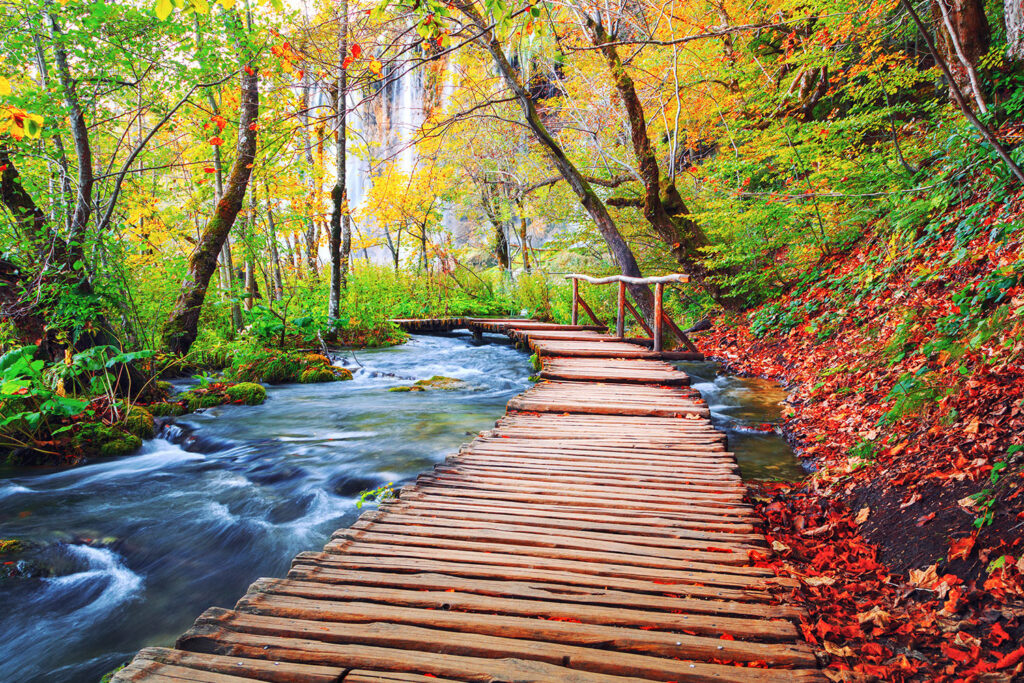
Plitvice Lakes National Park is not only the largest but also the oldest national park in Croatia. Its present charm is the result not only of nature’s generosity and the tufa barriers but also of the protection that this region has enjoyed since 1949. Thirty years later, the extraordinary ecosystem of the Plitvice Lakes received even greater recognition, earning a spot on the UNESCO World Heritage List. Over the following years, this area became one of the most important sites of nature conservation in the entire country.
Layout of the Plitvice Lakes National Park
Currently, the Plitvice Lakes National Park covers nearly 300 km². The vast majority of this area is occupied by vegetation, including both forests and grasslands. However, although they make up only 1% of the park’s total land, the true highlight of the park, its heart, and its main attraction is the system of 16 interconnected lakes.
The Plitvice Lakes complex is divided into two sets of cascading lakes – the Upper Lakes and the Lower Lakes. The Upper Lakes consist of twelve bodies of water: Okrugljak, Prošćansko jezero, Veliko jezero, Malo jezero, Milino jezero, Gradinsko jezero, Ciginovac, Batinovac, Vir, Galovac, Burgeti, and the largest of all – Kozjak Lake. These lakes were formed in layers of hard dolomite rocks, making them larger with gentler shorelines compared to the others. The Lower Lakes, which include Milanovac, Gavanovac, Kaluđerovac, and Novakovića Brod, are located on a more permeable limestone foundation. Their banks are much steeper, and the lakes themselves are smaller than the Upper Lakes.
Plitvice Water Bodies
Most sources state that the number of lakes in the Plitvice Lakes National Park is 16, but that’s not entirely accurate. This figure refers only to the largest and officially named bodies of water. When considering all the lakes in the park, that number would rise to a staggering 90. No one can predict exactly how this number might change in the coming years, as the rapid growth of the aforementioned tufa barriers could split a single lake into two smaller ones. Alternatively, two neighboring lakes might merge into one, as happened over 400 years ago with Kozjak Lake.
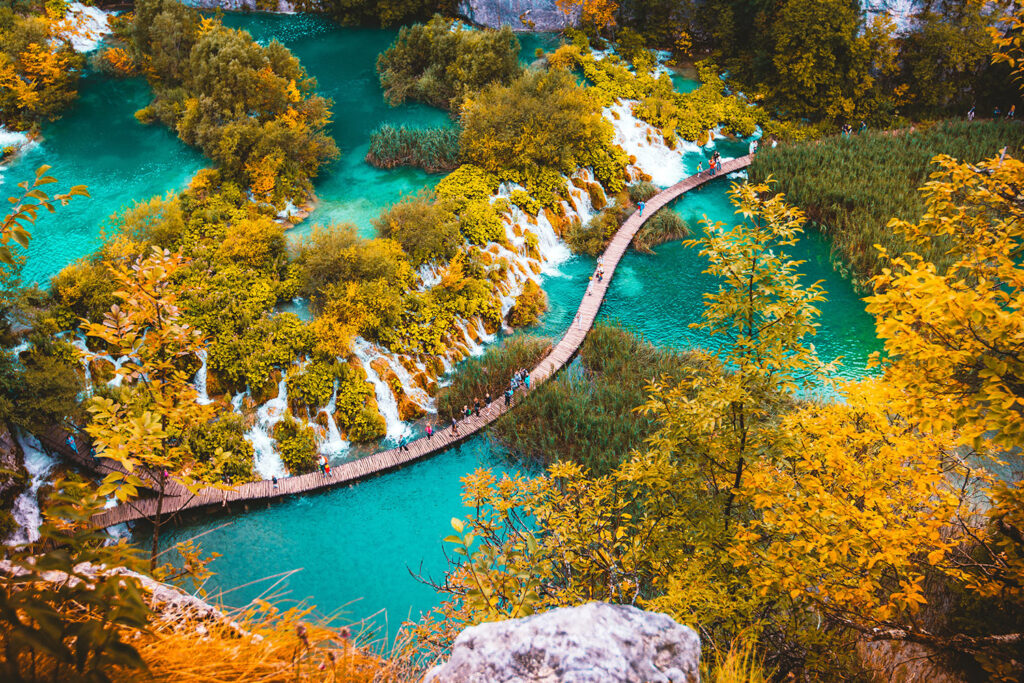
Regardless of whether we’re talking about 16 or 90 lakes, their undeniable charm cannot be disputed. The key factor that leaves visitors in awe is the wide array of colors displayed by the lakes, ranging from shades of emerald to turquoise and crystal-clear blues. This variation is influenced by chemical compounds in the water, aquatic vegetation, as well as weather conditions, sunlight angle, and the degree of illumination.
FUN FACT: None of the lake names are random; each one holds a story. Some refer to the shape or size of the lake (such as the round Okrugljak or the small Malo jezero), but not all follow this pattern. The name “Kozjak” commemorates the goats that, according to legend, drowned while fleeing from a wolf, and “Gavanovac” references a tale about a treasure that, some believe, still lies hidden at the bottom of the lake.
Kozjak Lake from a different perspective
While searching for information about the Plitvice Lakes online, you may come across photos of vacationers swimming freely in Kozjak Lake. Indeed, this was allowed a few years ago, but due to the damage caused by tourists, swimming in any lake within the park has been strictly prohibited since 2021. However, there is another way for visitors to experience Kozjak Lake from a different perspective. Head to Dock P1 and rent a small rowboat. This will allow you to paddle out to the middle of the lake, where you can marvel at the breathtaking colors of the water and the surrounding forests.
Waterfalls and cascades
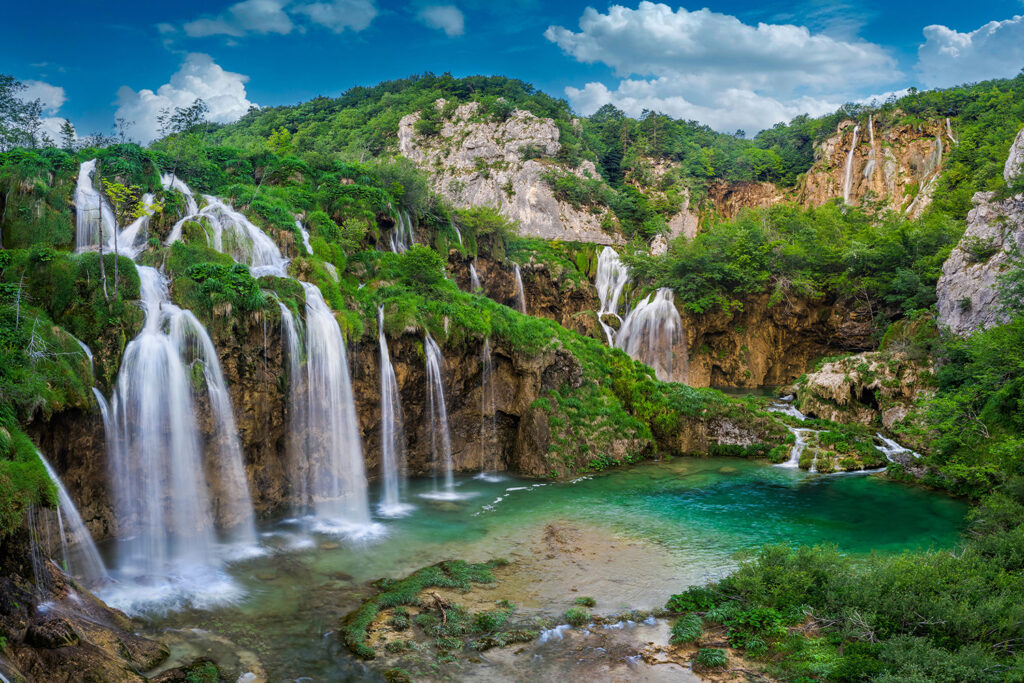
The various lakes in the park are situated at different elevations, allowing water to flow between them in the form of stunning cascades. The most famous of these is the Velike Kaskade, which gently flows amidst lush greenery, creating a harmonious network of streams. Nature truly shows off its skills here. However, even more impressive than the cascading streams are the waterfalls that can be seen at every turn.
The largest and most magnificent of these is Veliki Slap, located at the very end of the Lower Lakes. It’s not only the tallest waterfall in the park, but also the highest in all of Croatia, standing at 78 meters. It is fed by the waters of the Plitvica Potok River. Equally enchanting are the Sastavci Waterfall and the Veliki Prštavac Waterfall, formed on the edge of Gradinsko Lake and Galovacki Buk Lake.
Other attractions in the park
Karst processes have shaped not only lakes and waterfalls in the park but also caves. To date, more than 100 caves have been explored, but only one is open to tourists: Šupljara Cave. This cave was formed by the collapse of the valley floor, which served as its ceiling. It consists of three chambers connected by a 68-meter-long corridor. Unfortunately, only one chamber offers the chance to observe the decorative dripstone formations typical of caves.
Another fascinating result of natural forces is Karlovci, a site featuring vertical columns and rock blocks of varying shapes and sizes. Despite appearances, these dolomite rocks were not placed there for tourists’ enjoyment—they are the product of weathering processes that eroded the softer limestone once attached to the dolomites. You can easily find Karlovci while walking the trails in the park’s northwestern part, near the Čorkova Uvala rainforest.
Flora and fauna of Plitvice Lakes
Plitvice Lakes are not only a paradise for landscape lovers but also a sanctuary for a rich variety of flora and fauna. The national park is home to about 1,400 species of plants, including many rare and endemic species that are found only in this area. This is particularly impressive when you consider that it represents about 30% of Croatia’s total flora. This incredible biodiversity is due in large part to the park’s unique microclimate.
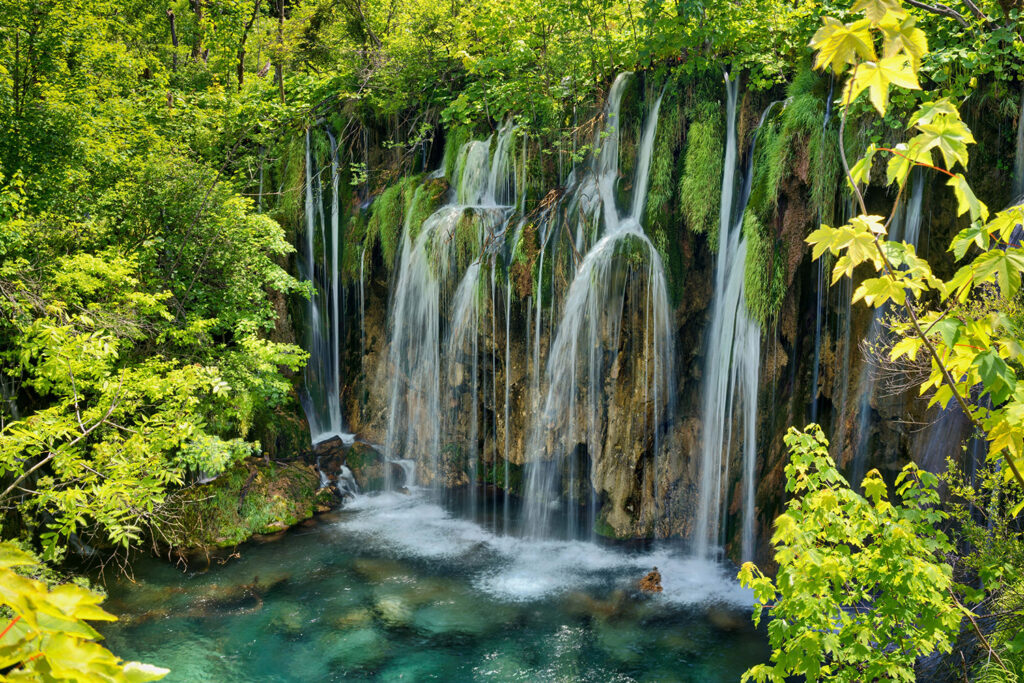
In the park, you can find typical forest and aquatic plant species, as well as three fascinating species of carnivorous plants, known for their unique diets. Mosses, which play a crucial role in the formation of tufa barriers, are regular residents, along with orchids that adorn the steep slopes and add to the park’s beauty.
The park’s fauna is just as impressive. The waters of Plitvice Lakes are home to several species of fish, with trout being the most prominent and a key element of the aquatic ecosystem. The park also provides refuge to rare and endangered bird species, such as black woodpeckers, golden eagles, and long-eared owls. In the denser parts of the forests surrounding the lakes, visitors may even encounter wolves, lynxes, deer, and occasionally bears. Traditional agricultural practices have also helped preserve the rare Lika Pramenka sheep, which graze in the park’s expansive meadows.
Visiting Plitvice Lakes
Plitvice Lakes National Park offers seven different walking trails for exploring the lake system. Some start at Entrance 1, while others begin at Entrance 2. The shortest trails are Route A and Route E. Route A departs from Entrance 1, taking visitors to see the Great Waterfall, the Lower Lakes, and the Kozjak Lake bridge. The circular Route E starts at Entrance 2 and primarily focuses on the Upper Lakes, also including a short boat ride across Kozjak Lake.

The slightly longer trails marked with B, C, and H offer a more extensive tour, covering both the most popular waterfalls, the Upper and Lower Lakes, and a few smaller nearby bodies of water. These trails also include a ride on the panoramic train and a cruise on an electric boat.
The longest trail, marked with the letter K, can be started from either entrance. This route provides a walking tour along the wooden walkways through a large portion of the lakes and waterfalls area. Along the way, you’ll encounter the Tomićevo Pogledalo viewpoint and enjoy a scenic walk along the shores of Kozjak Lake. Make sure to allocate a full day for this trail, as it covers approximately 17 km.
Additional hiking trails
In addition to the classic routes between the lakes, the park offers four additional hiking trails that lead you through the serene forest areas. These are perfect for mountain hiking enthusiasts. You can choose a longer, 2.5-hour trail to the east of Plitvice Lakes, or, if you’re short on time, just explore part of it. On this trail, you’ll have the opportunity to climb three peaks, the so-called Medveđak peaks, which rise over 800 m above sea level.
Another option is to explore the western side of the park. A much shorter and easier trail on this side is the 9 km Plitvica trail, which takes you through forested areas. If you’re up for a more demanding but equally rewarding adventure, consider the Zatoka Čorkova trail, which is a 21 km loop that will take you to the famous Čorkova Uvala rainforest. This forest is dominated by massive beech and fir trees, including a remarkable 500-year-old common fir, standing 58 m tall with a 150 cm diameter.
Plitvice Lakes by Train…
A popular way to explore the park, especially for those who prefer not to spend their vacation on long hikes, is by taking a ride on one of the panoramic transportation options. The first of these is the Plitvice “train”, which runs a 6.5 km shuttle route from Rapajinka to Velika Poljana and Labudovac. Though it’s called a train, it actually moves along a road and resembles more of a bus with wagons. The train route runs alongside most of the lakes, giving visitors a clear view of the park’s gems from all angles.
…and by Boat
Visitors also have access to a fleet of electric boats. These boats operate on both shorter routes across parts of the lakes and longer ones, allowing you to sail the full length of Kozjak Lake. Depending on the size of the boat, they can accommodate either 50 or 100 passengers. Boats typically depart every 30 minutes, and the longest ride across Kozjak Lake takes just over 20 minutes.
Before planning a visit by train or boat, it’s important to keep in mind that these attractions are extremely popular, particularly during peak season, and you may have to wait in fairly long lines to board. This is especially true since access to the train and boats is free once you present your park entrance ticket.
The Four Seasons in Plitvice Lakes National Park
The park is open to visitors year-round, and each season offers a distinct atmosphere and type of landscape. In spring, nature awakens throughout Plitvice Lakes, and the melting snow, combined with increased rainfall, makes the waterfalls especially photogenic. Summer brings a striking contrast between the lush greenery and the blue of the lakes, although it’s also the peak tourist season, with plenty of visitors enjoying the vibrant scenery. In autumn, the forests shimmer with gold and red hues, making the park even more picturesque. But what about the frosty winter?
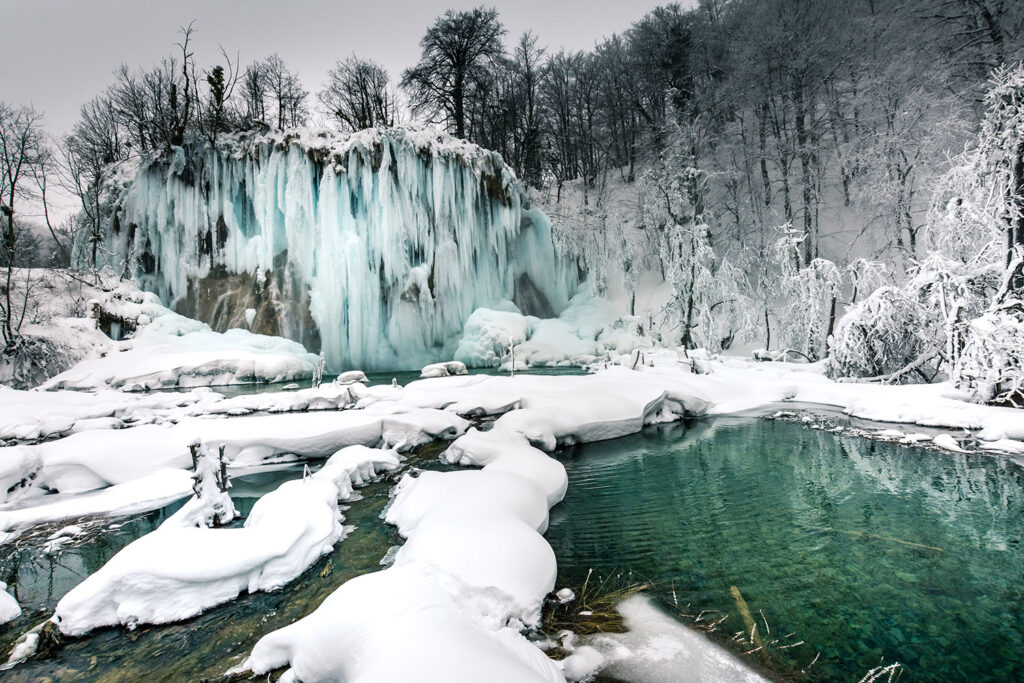
Skiing in the Land of Lakes
In winter, you can experience the park in a completely unexpected way. Besides admiring the frequently frozen waterfalls and snow-covered forests, there’s also the opportunity to go skiing. About 5 km from Entrance 1, in the village of Mukinje, lies a small ski resort equipped with a ski lift, taking skiers to a meadow at an elevation of around 700 meters above sea level.
This resort is not aimed at experienced skiers or snowboarders looking for adrenaline-filled slopes, but it’s a great spot for beginners or children to practice. The ski runs, though few in number, are each about 400 meters long, and the average slope gradient is a gentle 15%, making it ideal for novice skiers.
Park Rules
All visitors to Plitvice Lakes must remember they are walking through a national park, which means they must take special care and follow the park’s rules. Tourists should refrain from collecting natural souvenirs, feeding animals, and venturing off designated walking paths. Cycling is also prohibited within the main area of the park. However, for dedicated cycling enthusiasts, there’s a small exception: cycling is permitted in the southernmost (Plitvička Jezera municipality) and northernmost parts of the park (Rakovica municipality), where an organized and marked network of bike trails has been established.
Entry Tickets and a Few Tips
Where should you start when planning your trip? First, buy your tickets – preferably online, to avoid long queues at the ticket counters. The prices of tickets vary depending on the time of year you plan your visit. Your wallet will suffer the least from early November to late March, moderately in April, May, and October, and tickets are the most expensive from early June to the end of September. It is also during this peak summer period that the park tends to be the most crowded.
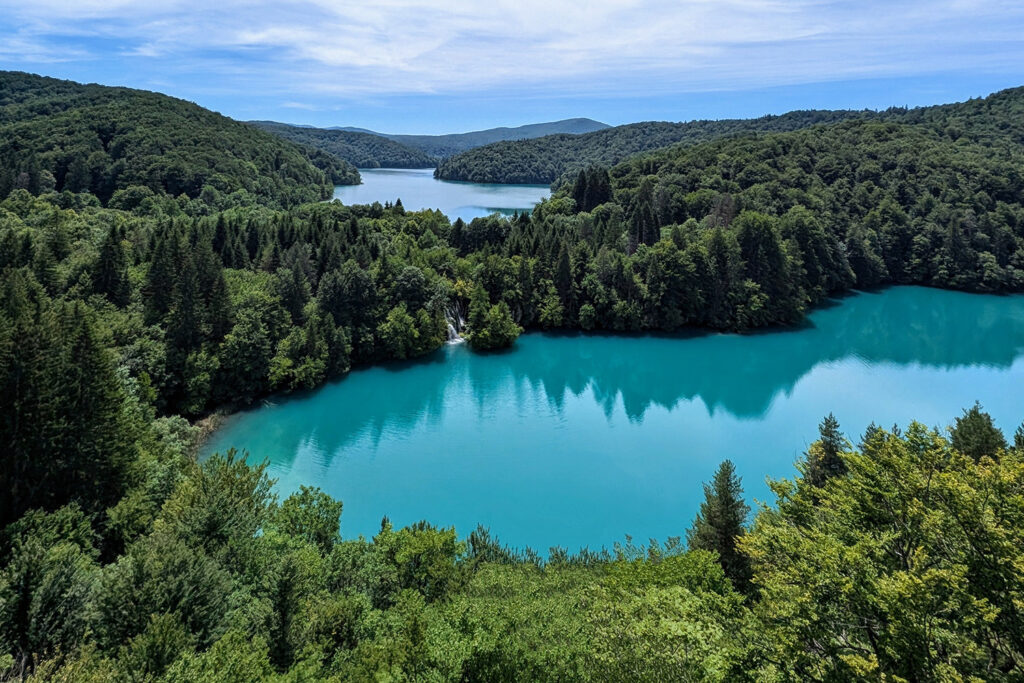
Due to the size of the park and the number of organized trails, many visitors choose to reserve at least two days for exploring Plitvice Lakes. For them, two-day tickets are available, offering a more economical way to fully experience the park’s beauty. To avoid the largest crowds, it’s best to arrive just before the park opens or in the afternoon. The latter option is particularly tempting if you’re looking to save money because during the summer months, ticket prices drop during the last few hours the park is open, and the views of the lakes sparkling in the setting sun are still breathtaking.
Regardless of whether you use Entrance 1 or Entrance 2, you can leave your car in the parking lots outside the park. The parking fee depends on the season and is charged for each hour you park. If you’d rather skip the hassle of parking, you can join organized tours that regularly depart from Zadar, Split, Zagreb, or Trogir. A wide selection of these tours can be found on this site, where you can also purchase entry tickets for Plitvice Lakes National Park.
Practical information
- It is best to purchase tickets for the Plitvice Lakes in advance. This way, you can avoid standing in long lines and reduce the risk of tickets being sold out.
- Buy tickets on GetYourGuide